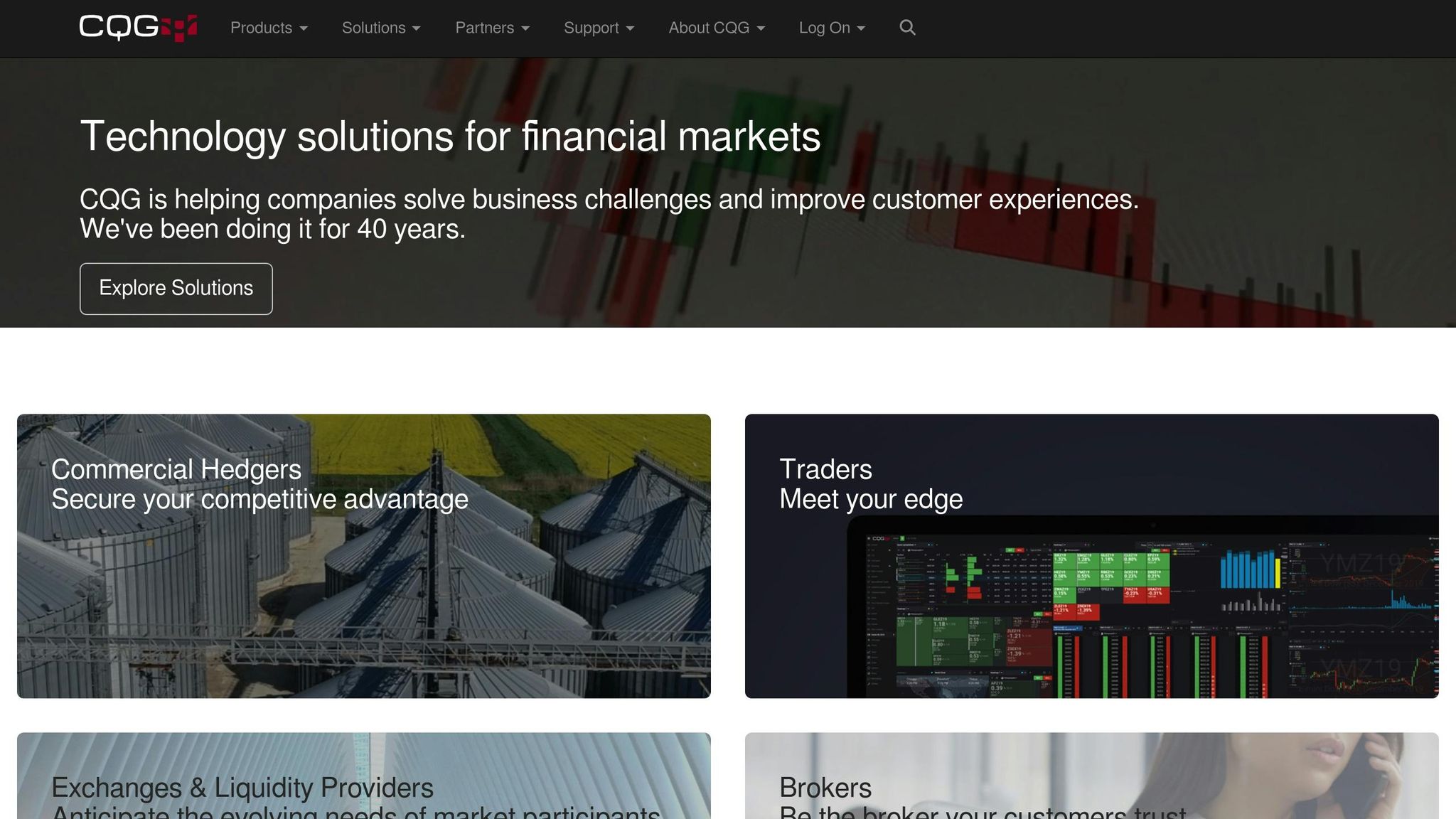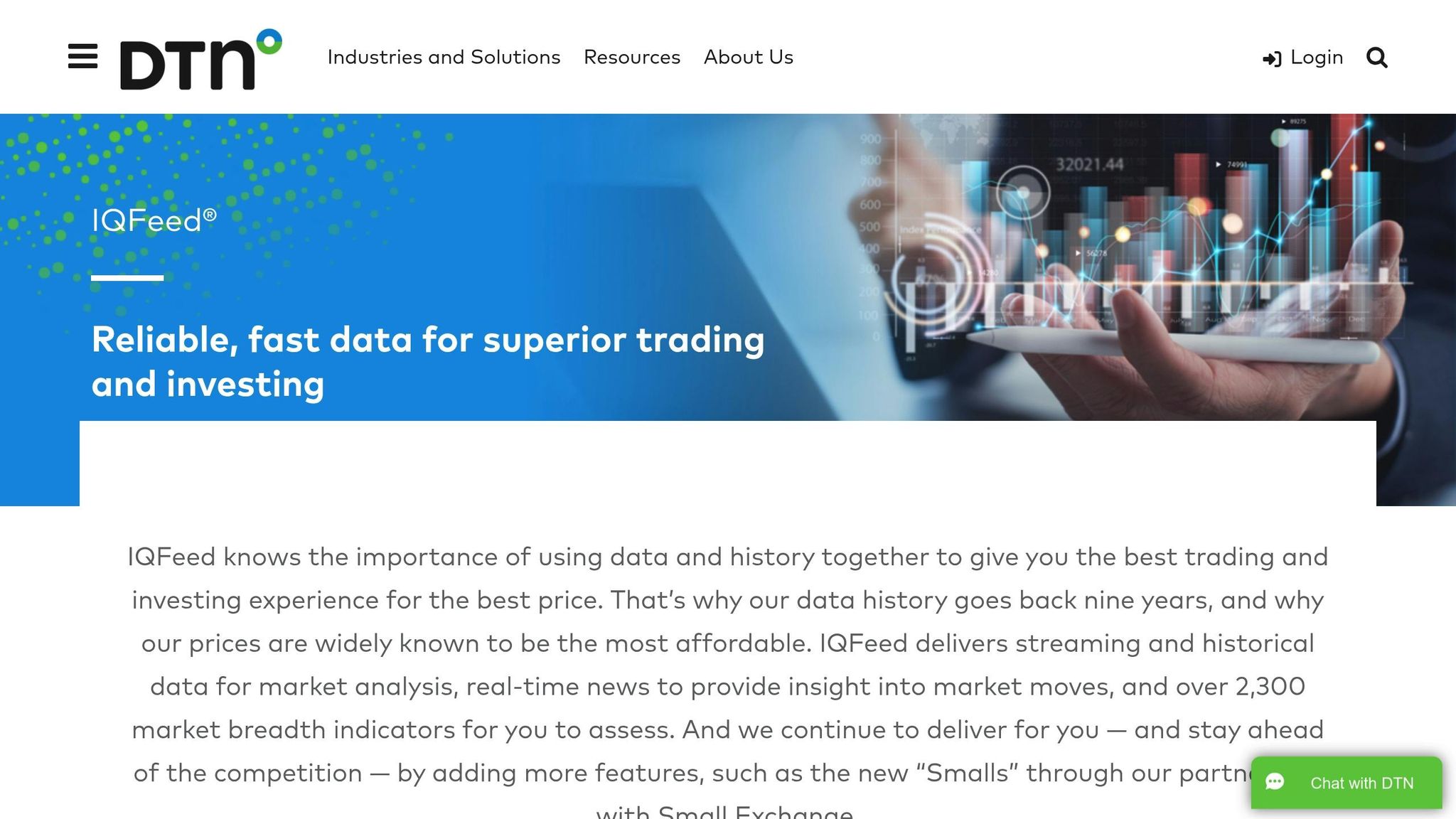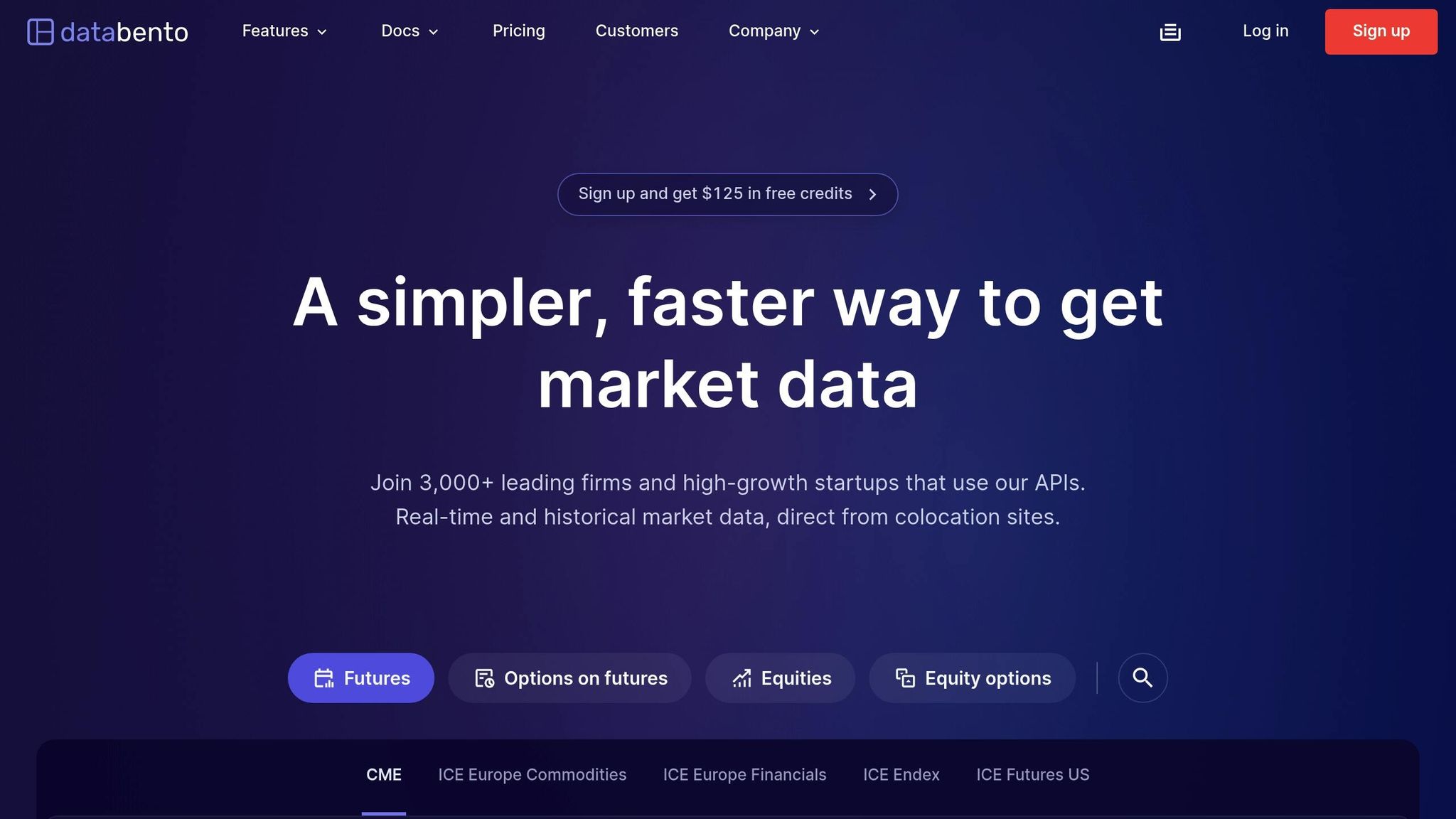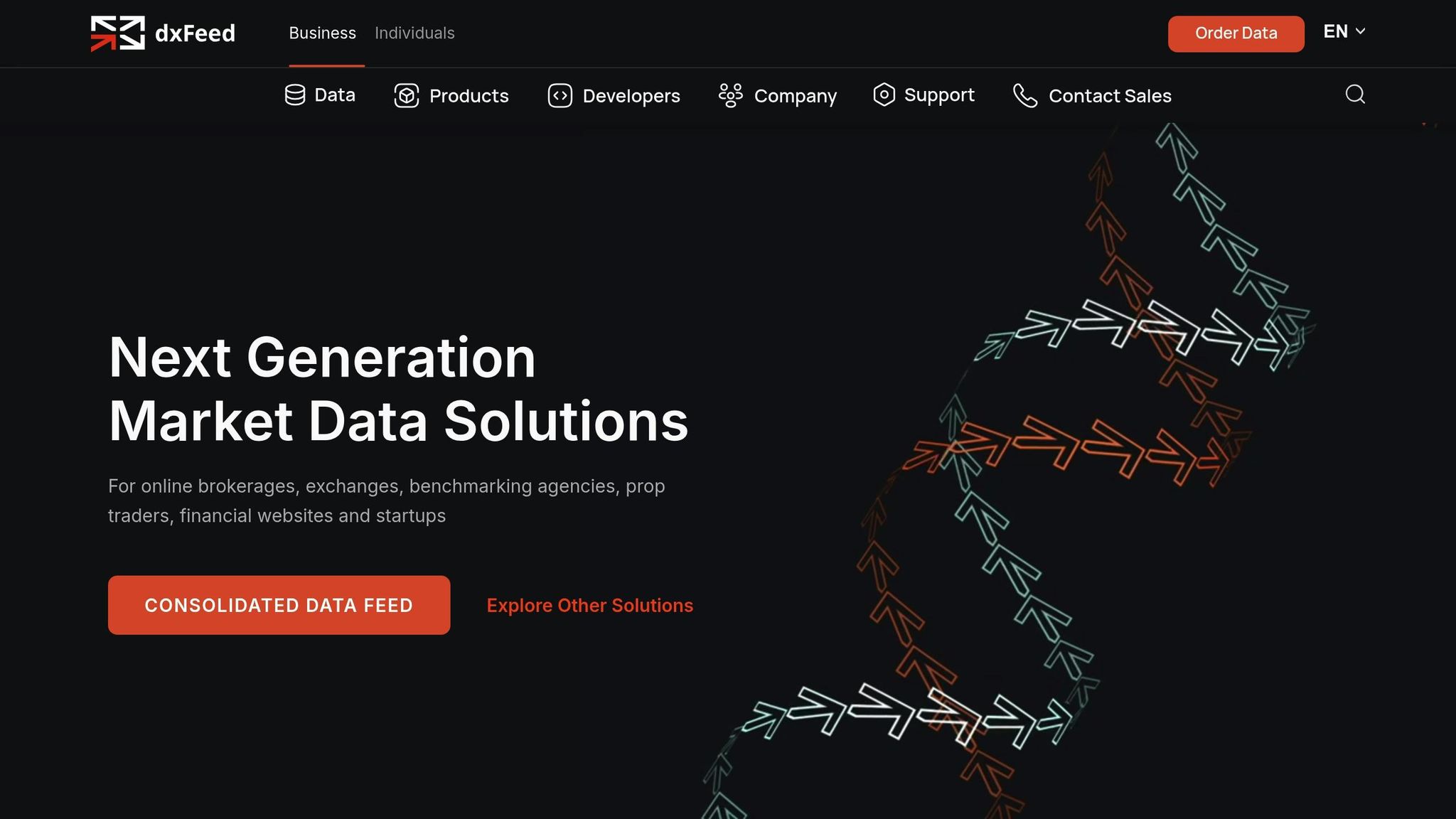Access to reliable tick and aggregated futures data is essential for traders in 2025. This guide breaks down the top providers, focusing on their strengths, weaknesses, and suitability for different trading needs. Here’s a quick overview:
- CQG: Known for global market coverage and low-latency data, ideal for institutions but expensive for smaller traders.
- Rithmic: Offers ultra-low latency and direct market access, perfect for high-frequency traders but lacks extensive historical data.
- DTN IQFeed: Affordable with rich historical data, but higher latency makes it less suitable for high-frequency trading.
- Databento: Flexible, developer-friendly, and cost-effective, though newer with limited market coverage.
- dxFeed: Enterprise-grade reliability and security, tailored for institutions, but pricing is less transparent.
Quick Comparison
| Provider | Strengths | Weaknesses |
|---|---|---|
| CQG | Broad market access, low latency | Expensive, complex setup |
| Rithmic | Ultra-low latency, direct exchange links | Limited historical data, basic support |
| DTN IQFeed | Affordable, rich historical data | Higher latency, basic analytics |
| Databento | Developer-friendly APIs, scalable pricing | Limited track record, fewer integrations |
| dxFeed | High uptime, secure infrastructure | Custom pricing, geared toward institutions |
Choosing the right provider depends on your trading style and priorities, whether it’s speed, affordability, or data depth. Keep reading for a detailed breakdown of each.
The Best Data Provider for Futures Trading: DTN, CQG, Rithmic, Interactive Brokers

1. CQG
CQG has established itself as a leading provider of futures data, offering both real-time and historical information sourced from more than 75 global exchanges. It’s a platform highly regarded by professional traders and institutions for its extensive market coverage and reliability.
Data Reliability
CQG is built on the promise of "robust, consistent performance", ensuring traders can focus on the markets without worrying about data interruptions. With a global network of strategically located data centers, including one in Shanghai, CQG ensures fast and seamless global connectivity. Its advanced servers, monitored 24/7, are designed to maintain uptime even during critical trading hours. The platform’s commitment to continuous improvements enables it to handle high-volume data delivery efficiently. This level of reliability is particularly vital during periods of market volatility, where uninterrupted and accurate data can make or break trading strategies. CQG’s infrastructure also supports ultra-low latency, a crucial feature for competitive trading.
Latency
When it comes to latency, CQG is a standout. Its co-located algorithmic trading engine provides reaction times measured in microseconds – an essential feature for high-frequency trading. The platform’s ability to manage complex strategy orders, such as spread orders, aggregated market orders, and smart iceberg orders, directly on CQG servers leverages its co-location advantage. This setup effectively eliminates geographic latency. For high-frequency traders, these ultra-low latency capabilities are invaluable, helping reduce implicit costs tied to building derivatives positions and improving the chances of achieving more passive fills. By combining reliable data delivery with lightning-fast execution, CQG equips traders with the tools they need to stay ahead in the markets.
2. Rithmic
Rithmic provides direct market access and ultra-low latency futures data through dedicated connections to major U.S. exchanges.
Data Reliability
Rithmic focuses on creating direct connections with key exchanges to cut down on delays and avoid dependence on third-party data aggregators. This setup is designed to uphold data accuracy and ensure a continuous stream of market information. The result is a stable data pipeline that supports the platform’s ultra-low latency capabilities.
Latency
To keep latency to a minimum, Rithmic uses co-location and a native API. This setup is crucial for delivering the kind of rapid order execution that algorithmic trading demands.
Platform Compatibility
Rithmic works seamlessly with platforms like NinjaTrader, MultiCharts, and Sierra Chart. Its API also supports multiple programming languages, making it adaptable for custom trading solutions.
Pricing
Rithmic offers tiered pricing plans to suit different needs, including options for both current and historical tick data. There are also packages available for extended data coverage.
3. DTN IQFeed

DTN IQFeed is a prominent data provider, offering reliable futures data tailored for both retail and institutional traders across the United States.
Data Reliability
Although specific technical details aren’t shared, DTN IQFeed employs proprietary methods to ensure accurate and consistent data delivery during market hours.
Latency
For algorithmic traders, low latency is a crucial factor. DTN IQFeed has focused on enhancing its infrastructure to ensure quick and reliable data transmission. While exact latency figures aren’t provided, these improvements aim to meet the fast-paced demands of modern trading.
Platform Compatibility
DTN IQFeed works seamlessly with popular platforms like TradeStation, eSignal, AmiBroker, and MetaStock. It also supports integration with custom trading systems through a variety of API options, accommodating widely-used development frameworks and programming languages.
Pricing
DTN IQFeed operates on a subscription-based pricing model. The cost depends on the scope of real-time data access and the depth of historical data required.
4. Databento

Databento stands out as a cutting-edge data provider, tailored to meet the demands of futures trading. By combining advanced technology with user-friendly tools, it delivers institutional-grade market data that traders and developers can rely on.
Data Reliability
When it comes to data reliability, Databento delivers the precision and speed that professional trading environments demand. Offering high-resolution, real-time, and historical data across equities, options, and futures markets, the platform is built on a robust infrastructure. This ensures consistent and accurate feeds, whether you’re backtesting strategies or executing live trades. For quantitative researchers and algorithmic traders, this level of reliability is crucial, especially as the market continues to demand low-latency and high-fidelity data for futures trading in 2025.
Platform Compatibility
Databento takes compatibility to the next level by offering official client libraries for Python, C++, and Rust, along with a TCP socket Raw API that works with any programming language. These tools make it easy to integrate Databento into various workflows, including Jupyter notebooks, which are widely used in quantitative research. As C. Garcia, a Senior Quant Researcher from a leading options market maker, put it:
"Databento makes it really easy to get data in my data exploration workflows and Jupyter notebooks."
In August 2025, Databento further solidified its reputation by partnering with Tickblaze. This collaboration brought institutional-grade market data to Tickblaze for more efficient backtesting and analysis. Additionally, Databento supports advanced analytics through its integration with stream processing platforms. For example, a recent tutorial demonstrated how its data can be combined with RisingWave to perform real-time VWAP calculations. These integrations highlight Databento’s focus on creating a seamless and efficient trading experience.
Pricing
Databento’s pricing model is designed with flexibility in mind, catering to both individual traders and large institutions. Subscription costs depend on the scope of data access, whether real-time or historical, and the depth of data required. This scalable approach ensures that users only pay for what they need.
5. dxFeed

dxFeed stands out as a reliable provider of market data services, specifically tailored for the futures trading sector. By combining enterprise-grade infrastructure with advanced security protocols, dxFeed ensures seamless data delivery for institutional and professional trading environments. The platform is designed to provide high-quality tick and aggregated data through its extensive global network.
Data Reliability
When it comes to reliability, dxFeed sets a high bar. The company has implemented multiple layers of security and operational measures to guarantee consistent service. Notably, dxFeed completed its 2024–2025 SOC 2 Type 2 audit, earning a clean report from A-LIGN, a globally recognized cybersecurity and compliance firm. This annual audit validates the platform’s adherence to strict standards for information security, confidentiality, and availability.
The platform’s infrastructure directly connects feed handlers to market data sources, ensuring precise and high-quality data collection. dxFeed processes an enormous amount of data daily, handling up to 10TB of raw data through parsing, indexing, and storage. This capability underscores its ability to meet the rigorous demands of futures trading.
"Passing the SOC 2 Type 2 audit is not just a routine – it’s a reflection of our continuous commitment to delivering secure and reliable services", said Oleg Solodukhin, CEO of dxFeed.
Beyond audits, dxFeed has proven its resilience through the 2024 SIFMA/FIA Industry-Wide BC and DR Testing. This achievement highlights the platform’s ability to maintain operations even during challenging scenarios that could disrupt market data delivery.
Platform Compatibility
dxFeed’s robust infrastructure also shines when it comes to platform compatibility. Leveraging cloud computing, dxFeed offers virtually unlimited scalability to store millisecond time-stamped tick data. This ensures the platform can seamlessly handle fluctuating data volumes and diverse user needs without sacrificing performance.
The global market data network is built with flexible redundancy setups and multiple points of presence, ensuring uninterrupted data access. This design provides consistent delivery of futures data, regardless of location or network conditions, offering users peace of mind.
Pricing
While dxFeed does not publicly disclose standard pricing tiers, its focus on institutional clients suggests that pricing is customized to meet specific enterprise needs. The platform also offers round-the-clock support, 24x7x365, as a core part of its services, emphasizing its commitment to comprehensive service packages rather than basic data-only plans.
With an impressive 99.98% uptime and the ability to handle up to 10,000,000 messages per second, dxFeed’s infrastructure reflects the high-performance standards that institutional clients expect. These specifications underline the premium nature of its offerings, making it a dependable choice for futures trading professionals.
Pros and Cons
Understanding the trade-offs between providers is essential for evaluating their impact on your trading operations. Each provider offers distinct strengths and limitations that can shape your experience and outcomes in different ways.
Here’s a breakdown of the key advantages and drawbacks for each provider:
| Provider | Strengths | Weaknesses |
|---|---|---|
| CQG | Enterprise-level reliability with strong institutional backing, global futures coverage, advanced charting and analytics, trusted by professionals | High pricing; steep learning curve for beginners; requires significant system resources. |
| Rithmic | Ultra-low latency ideal for high-frequency trading, direct market access, robust API for algorithmic trading, competitive pricing | Limited historical data; minimal customer support; fewer additional resources. |
| DTN IQFeed | Affordable and transparent pricing, extensive historical data, reliable performance, user-friendly for retail traders | Higher latency for high-frequency trading; limited customization; basic analytical tools. |
| Databento | Cloud-native infrastructure, flexible data formats, transparent usage-based pricing, developer-friendly APIs | Newer provider with limited track record, narrower data coverage, fewer third-party integrations. |
| dxFeed | High uptime, strong security certifications, capable of handling large data volumes, 24/7 support | Custom pricing with less transparency; geared toward institutional clients; fewer retail resources. |
Key Differences
- Reliability: dxFeed stands out for uptime and security, while CQG is trusted for its broad market coverage and institutional reputation.
- Latency: Rithmic is designed for ultra-low latency, whereas DTN IQFeed focuses on providing deep historical data for analysis.
- Pricing: DTN IQFeed and Databento offer clear and transparent pricing, while CQG and dxFeed use custom enterprise models that may complicate budgeting.
- Compatibility: Databento emphasizes modern APIs and cloud-based integration, while CQG supports broader integrations but requires more complex setups.
- Support and Transparency: Support quality and pricing transparency vary widely, making it crucial to align your provider choice with your trading goals.
Conclusion
Choosing the right futures data provider depends heavily on your trading style and priorities. High-frequency traders might lean toward Rithmic for its ultra-low latency, while discretionary traders could benefit more from CQG’s extensive analytics and global market access. For those keeping an eye on costs, budget-conscious traders will appreciate DTN IQFeed’s straightforward pricing and rich historical data.
Each provider has its strengths, and aligning those with your needs is key. Algorithmic traders will find Databento’s flexible, cloud-native APIs highly adaptable, while institutional traders often turn to dxFeed for its enterprise-level reliability and performance. Whether your focus is speed, affordability, data depth, or analytics, matching your priorities with the right provider is essential.
But there’s more to consider than just the data provider. Network latency and server reliability play a huge role in ensuring your data performs as expected. For serious traders, this is where investing in a solid VPS infrastructure becomes indispensable.
QuantVPS takes data performance to the next level by offering ultra-low latency connections (0-1ms) and guaranteed uptime, ensuring your data feeds stay stable during critical market moments. With dedicated resources, QuantVPS eliminates the delays that can hinder data delivery. Plus, its compatibility with widely-used trading platforms like NinjaTrader and TradeStation ensures smooth integration, whether you’re using CQG’s enterprise tools or Rithmic’s high-speed feeds.
FAQs
What should I look for in a futures data provider in 2025?
When choosing a futures data provider in 2025, it’s crucial to prioritize accuracy, reliability, and timeliness to ensure you can make well-informed trading decisions. The data should be consistent, free of errors, and thoroughly validated with advanced tools to maintain precision.
It’s also important to check how well the provider integrates with your trading platform. A smooth integration can save you time and help you avoid unnecessary technical headaches. On top of that, look into the pricing structure to ensure it’s clear and straightforward. See if the provider offers customizable features that align with your specific trading or backtesting needs. Aim for a provider that strikes the right balance between affordability and powerful features, helping you get the most out of your trading strategies.
How does latency affect trading performance, and which provider offers the best low-latency solution for futures data?
Latency is a key factor in trading performance, especially when it comes to the speed of order execution. In the world of high-frequency trading, even a delay of just a few microseconds can affect profitability. That’s why having low-latency solutions is crucial for staying competitive in futures trading.
QuantVPS offers lightning-fast low-latency solutions with response times ranging from 0 to 1 millisecond, making it a perfect choice for traders who depend on rapid execution. Similarly, providers like dxFeed focus on delivering ultra-fast futures data through direct exchange connections. This ensures reliable and incredibly quick data delivery designed specifically for the demands of quantitative traders.
What are the benefits of using cloud-native infrastructure like Databento for futures trading data?
Using a cloud-native infrastructure like Databento brings several advantages for handling futures trading data. One standout benefit is the ability to scale effortlessly, accommodating large volumes of both real-time and historical data. This scalability empowers traders to perform analytics faster and make better-informed decisions – crucial for quantitative and high-frequency trading strategies.
Another key advantage is access to low-latency APIs, which ensure quick and reliable data delivery. On top of that, cloud-native systems are built with strong disaster recovery measures and high availability, reducing downtime and keeping trading operations running smoothly. For traders who rely on precise and timely data for backtesting or live trading, these features are game-changers.








